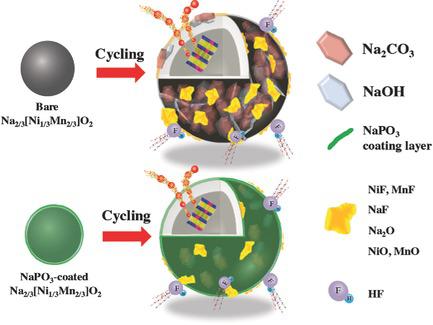当前位置:
X-MOL 学术
›
Adv. Funct. Mater.
›
论文详情
Our official English website, www.x-mol.net, welcomes your
feedback! (Note: you will need to create a separate account there.)
Sodium‐Ion Batteries: Building Effective Layered Cathode Materials with Long‐Term Cycling by Modifying the Surface via Sodium Phosphate
Advanced Functional Materials ( IF 18.5 ) Pub Date : 2018-02-05 , DOI: 10.1002/adfm.201705968 Jae Hyeon Jo 1 , Ji Ung Choi 1 , Aishuak Konarov 1 , Hitoshi Yashiro 2 , Shuai Yuan 3 , Liyi Shi 3 , Yang-Kook Sun 4 , Seung-Taek Myung 1
Advanced Functional Materials ( IF 18.5 ) Pub Date : 2018-02-05 , DOI: 10.1002/adfm.201705968 Jae Hyeon Jo 1 , Ji Ung Choi 1 , Aishuak Konarov 1 , Hitoshi Yashiro 2 , Shuai Yuan 3 , Liyi Shi 3 , Yang-Kook Sun 4 , Seung-Taek Myung 1
Affiliation

|
Surface stabilization of cathode materials is urgent for guaranteeing long‐term cyclability, and is important in Na cells where a corrosive Na‐based electrolyte is used. The surface of P2‐type layered Na2/3[Ni1/3Mn2/3]O2 is modified with ionic, conducting sodium phosphate (NaPO3) nanolayers, ≈10 nm in thickness, via melt‐impregnation at 300 °C; the nanolayers are autogenously formed from the reaction of NH4H2PO4 with surface sodium residues. Although the material suffers from a large anisotropic change in the c‐axis due to transformation from the P2 to O2 phase above 4 V versus Na+/Na, the NaPO3‐coated Na2/3[Ni1/3Mn2/3]O2/hard carbon full cell exhibits excellent capacity retention for 300 cycles, with 73% retention. The surface NaPO3 nanolayers positively impact the cell performance by scavenging HF and H2O in the electrolyte, leading to less formation of byproducts on the surface of the cathodes, which lowers the cell resistance, as evidenced by X‐ray photoelectron spectroscopy and time‐of‐flight secondary‐ion mass spectroscopy. Time‐resolved in situ high‐temperature X‐ray diffraction study reveals that the NaPO3 coating layer is delayed for decomposition to Mn3O4, thereby suppressing oxygen release in the highly desodiated state, enabling delay of exothermic decomposition. The findings presented herein are applicable to the development of high‐voltage cathode materials for sodium batteries.
中文翻译:

钠离子电池:通过磷酸钠修饰表面来构建具有长期循环功能的有效分层阴极材料
阴极材料的表面稳定化对于保证长期可循环性非常重要,并且在使用腐蚀性Na基电解质的Na电池中也很重要。P2型层状Na 2/3 [Ni 1/3 Mn 2/3 ] O 2的表面经过300°C的熔融浸渍处理,形成了离子导电磷酸钠(NaPO 3)纳米层,厚度约10 nm。 C; 纳米层是由NH 4 H 2 PO 4与表面钠残基的反应自生形成的。尽管该材料在4 V以上与Na +相比从P2相转变为O2相,但在c轴上存在较大的各向异性变化/ Na,NaPO 3涂层的Na 2/3 [Ni 1/3 Mn 2/3 ] O 2 /硬碳全电池在300个循环中表现出出色的容量保持率,保留率达73%。X射线光电子能谱和时间证明,NaPO 3表面纳米层通过清除电解质中的HF和H 2 O积极地影响电池性能,从而减少了阴极表面副产物的形成,从而降低了电池电阻。飞行中二次离子质谱 时间分辨的原位高温X射线衍射研究表明,NaPO 3涂层被延迟分解为Mn 3 O 4,从而抑制了高度脱氧状态下的氧气释放,从而延迟了放热分解。本文介绍的发现适用于钠电池高压阴极材料的开发。
更新日期:2018-02-05
中文翻译:

钠离子电池:通过磷酸钠修饰表面来构建具有长期循环功能的有效分层阴极材料
阴极材料的表面稳定化对于保证长期可循环性非常重要,并且在使用腐蚀性Na基电解质的Na电池中也很重要。P2型层状Na 2/3 [Ni 1/3 Mn 2/3 ] O 2的表面经过300°C的熔融浸渍处理,形成了离子导电磷酸钠(NaPO 3)纳米层,厚度约10 nm。 C; 纳米层是由NH 4 H 2 PO 4与表面钠残基的反应自生形成的。尽管该材料在4 V以上与Na +相比从P2相转变为O2相,但在c轴上存在较大的各向异性变化/ Na,NaPO 3涂层的Na 2/3 [Ni 1/3 Mn 2/3 ] O 2 /硬碳全电池在300个循环中表现出出色的容量保持率,保留率达73%。X射线光电子能谱和时间证明,NaPO 3表面纳米层通过清除电解质中的HF和H 2 O积极地影响电池性能,从而减少了阴极表面副产物的形成,从而降低了电池电阻。飞行中二次离子质谱 时间分辨的原位高温X射线衍射研究表明,NaPO 3涂层被延迟分解为Mn 3 O 4,从而抑制了高度脱氧状态下的氧气释放,从而延迟了放热分解。本文介绍的发现适用于钠电池高压阴极材料的开发。











































 京公网安备 11010802027423号
京公网安备 11010802027423号